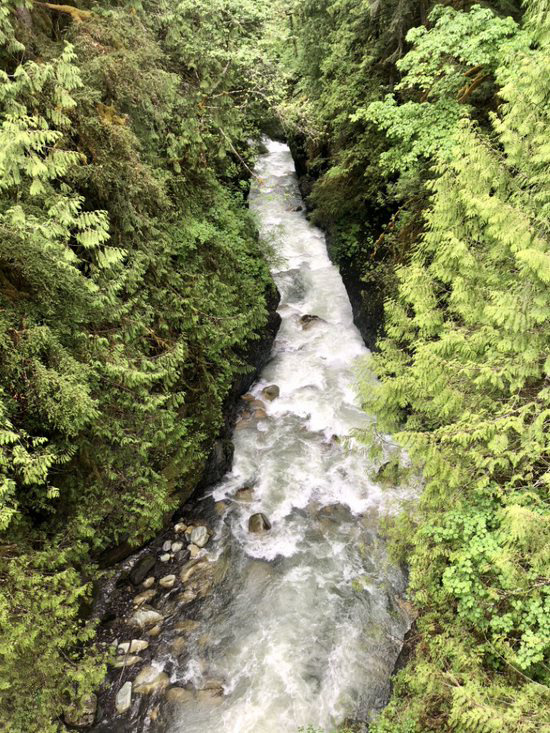Nooksack River Transboundary Technical Collaboration Group 2019-2020 annual report
The Nooksack River watershed spans part of the border between British Columbia and the State of Washington. In August 2018, the international, multi-agency Nooksack River Transboundary Technical Collaboration Group (TCG) was established to implement a three-year work plan to reduce fecal bacteria concentrations in the Nooksack River watershed. This 2019-2020 TCG annual report summarizes second year project activities and focuses on three of the watershed's transborder sub-basins.

Executive Summary
In August 2019, the British Columbia (B.C.) - Washington (WA) Nooksack River Transboundary Technical Collaboration Group (TCG) began its second year of coordinated work to reduce fecal indicator bacteria concentrations (fecal bacteria) in the Nooksack River watershed. This 2019-2020 TCG annual report summarizes second year project activities and focuses on the three sub-basins of the Nooksack River watershed that span the border between B.C., Canada and the State of Washington (WA), United States of America.
During the past year, B.C. and WA partners sampled surface water throughout the lower Nooksack River watershed, including sites located at the international border. In 2019 B.C. and WA partners set short-term (by 2021) and long-term (by 2024) border benchmarks for Escherichia coli (E. coli) concentrations at four border monitoring sites. B.C. data analysis shows that 2019 dry and wet season E. coli concentrations met the short-term border benchmark at the border sites, except for Cave Creek during the summer. However, B.C. and WA data analysis for 2019-2020 noted an increase in fecal bacteria concentrations in the Bertrand, Pepin, and Fishtrap sub-basins when compared to the 2018-2019 period. Throughout the Bertrand and Pepin sub-basins, elevated fecal coliform and E. coli concentrations were more common during the wet season (October to March) and following significant rain events. This data supports that the wet season is the critical period to focus pollution identification and correction (PIC) efforts to sustain progress toward overall reduced fecal coliform levels and ultimately to marine water quality that supports year-round shellfish harvest throughout the Portage Bay Shellfish Growing Area.
The Nooksack River is the largest freshwater source to Portage Bay and to the Lummi Nation’s Portage Bay Shellfish Growing Area. Multi-year efforts to reduce fecal bacteria concentrations have successfully improved spring season water quality in the Conditionally Approved portion of the shellfish growing area. In early 2019, access to spring season shellfish harvest in Portage Bay was restored. The area remains closed to harvest from October-December each year due to fall and early winter season elevated concentrations of fecal coliform in the marine water.
TCG work to reduce fecal bacteria concentrations in the Nooksack River watershed continues. B.C. and WA collected water samples to help identify potential fecal bacteria sources. Agencies acted on complaints, offered technical assistance to control fecal bacteria sources, and conducted regulatory compliance activities. Both jurisdictions engaged commercial and non-commercial agricultural, rural residential, and suburban community members through non- regulatory education and outreach.
A TCG outreach subcommittee promoted compliance and shared event schedules and education materials. A TCG data subcommittee discussed monitoring data and status relative to E. coli concentration border benchmarks. This report includes a resource list and an assessment of results in comparison to the short- and long-term benchmarks.
Based on completion of the project’s second year, the TCG recommends that the remaining data comparability assessment workplan item be completed as soon as COVID-19 related international travel restrictions are lifted. Additionally, during the fall 2020 wet season, WA will sample and analyze for E. coli at border locations following similar frequency and timing as B.C. As future budget allows, WA may also complete 2021 dry season border E. coli sampling aligned with B.C. frequency and timing. This shared process will help evaluate E. coli results for this project’s final year.
Overall, 2019-2020 water quality monitoring results show deteriorating water quality (increased fecal bacteria) in the transboundary waterways compared to 2018-2019 reporting period. This observation is largely driven by seasonally elevated fecal bacteria and rain events. However, compliance, stewardship, and communication activities continue to successfully reach key audiences and help to address fecal bacteria concentration sources. The TCG will continue to implement work plan tasks during the 2020-2021 project period.

